Ever thought you’re spending too much on nail fungus treatments? There are many options out there, but how do you know which one works?
The debate on treating nail fungus is intense. You have prescription meds and over-the-counter solutions. It’s important to pick the right one for your health. But, which one really works? We’ll explore the good and bad of each, guiding you to the best treatment.
Quick Recommendation: Our blog covers prescription vs over-the-counter treatments for nail fungus. Are you looking for a solution to treat your nail fungus? We recommend Metanail.
Understanding Nail Fungus
Nail fungus, also known as onychomycosis, is a common issue that affects your nails. It starts as a small white or yellow spot under the tip of your nail. Over time, it spreads deeper into the nail.
Symptoms include nail discoloration, thickening, and brittleness. You might also see a distorted shape or crumbly edges. Sometimes, the nail smells bad. While toenails are more often affected, fingernails can get infected too.
Onychomycosis can make everyday activities uncomfortable and sometimes painful. In severe cases, it can cause permanent damage to your nails. Knowing the signs of fungal infections helps you take care of your nails better.
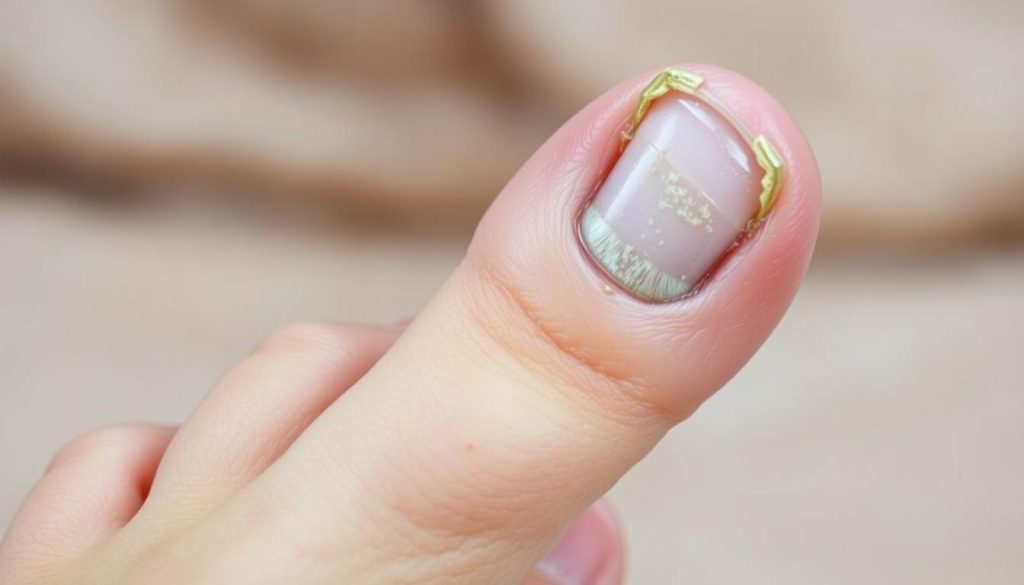
Causes of Nail Fungus
It’s important to know why nail fungus happens to stop and treat it. Fungi, especially dermatophytes, cause most infections. They love warm, moist places like public showers and pools.
Getting your nails hurt can also lead to fungus. This is especially true if you often have wet feet.
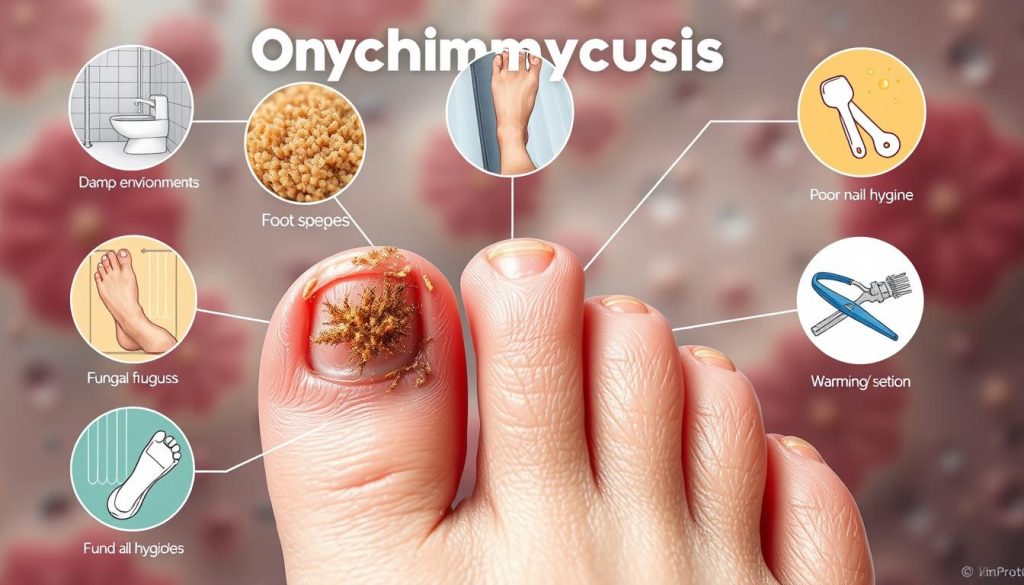
There are many reasons you might get nail fungus. Getting older makes you more likely because your blood flow and nail growth slow down. People with diabetes or weak immune systems are also at higher risk.
Why Treat Nail Fungus?
It’s crucial to tackle nail fungus problems quickly. If not treated, it can cause a lot of pain. It might even spread to other parts of your body. Understanding the need to treat onychomycosis helps stop it from getting worse.
Not treating nail fungus can also hurt your looks and feelings. Your nails might turn color, get thick, and change shape. This can make you feel bad about yourself and lower your confidence. Getting your nails healthy again can boost your self-esteem.
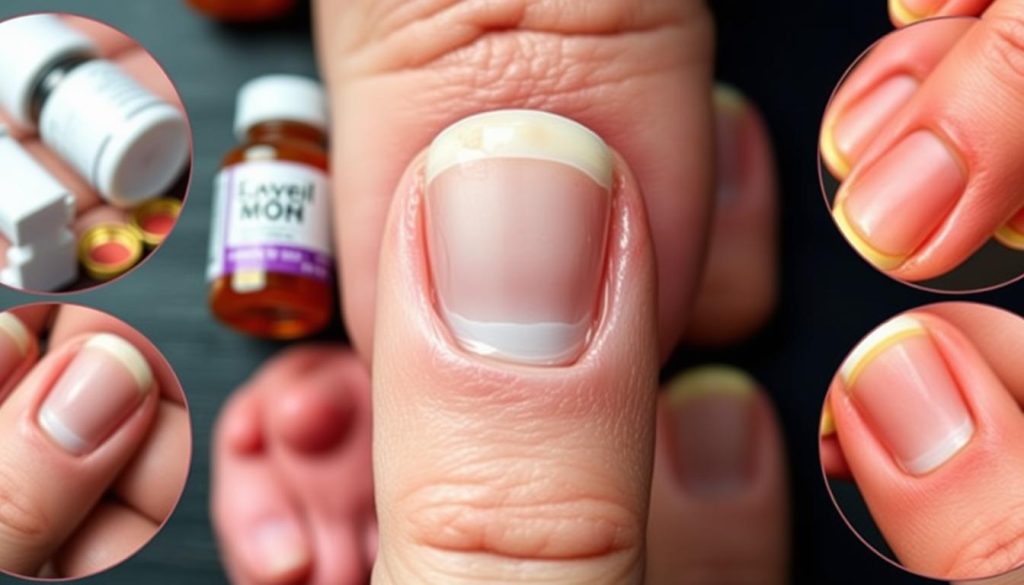
In serious cases, not treating nail fungus can be risky. This is especially true if you have diabetes or a weak immune system. Treating onychomycosis is key to avoiding these risks.
Types of Treatments Available
There are many ways to fight nail fungus, each with its own success rate. You can choose from easy-to-use topical ointments or stronger oral medications. Topical treatments, like creams and ointments, are a common first choice. They are part of the antifungal therapies group.
Oral medications, on the other hand, go deeper into the nail bed. They need a longer time to work and might have side effects. But, FDA-approved treatments like Terbinafine and Itraconazole are known to work well.
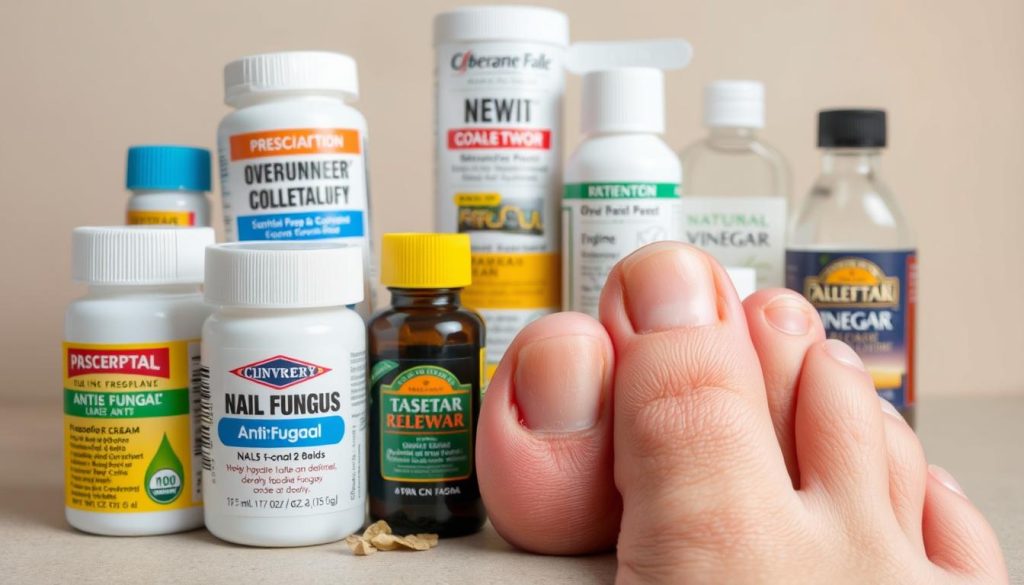
Laser therapy is another option. It uses laser light to kill fungal infections. It’s effective but might need many sessions and can be expensive.
Some people also look into home remedies and alternative medicine. Options like tea tree oil and vinegar soaks are popular. But, these might not work as well as proven treatments and need long-term use.
Deciding on a treatment depends on your needs, health history, and how bad the fungus is. Always talk to a doctor to find the best option for you.
Prescription Treatments for Nail Fungus
Dealing with a stubborn nail fungus? Antifungal prescriptions might be the answer. Your doctor might suggest terbinafine or itraconazole. These medicines stop fungi from growing, making them great for tough infections.
Systemic treatment for onychomycosis is another option. It uses oral medications. This method targets the infection from inside, boosting the chance of getting rid of the fungus.
To get these prescriptions, you need a proper diagnosis. A healthcare professional will confirm the fungal infection. They might do a physical check and lab tests to find the fungus type.
Remember, prescription treatments need a doctor’s help. They ensure you get the right amount and treatment time. By following your doctor’s advice, you can fight nail fungus and get your nails healthy again.
Quick Recommendation: Our blog covers prescription vs over-the-counter treatments for nail fungus. Are you looking for a solution to treat your nail fungus? We recommend Metanail.
Over-the-Counter Treatments for Nail Fungus
There are many over-the-counter (OTC) options for nail fungus. These OTC nail fungus medications are cheaper than prescription treatments. You can find antifungal lacquers, creams, and ointments at most pharmacies.
Topical antifungals are key in these treatments. Ingredients like tolnaftate and clotrimazole stop fungi from growing. This helps your body fight off the infection.
OTC treatments are easy to get and affordable. You don’t need a doctor’s prescription. This makes them a good choice for many people. Just make sure to use them as directed for the best results.
If you have a mild case of nail fungus, topical antifungals and other OTC treatments are worth trying. They are easy to use and won’t break the bank.
Side Effects and Precautions
When picking a treatment for nail fungus, it’s key to think about side effects and precautions. Prescription treatments, like oral antifungal medicines, can work well but might have bad effects. Common issues include headaches, dizziness, and skin rashes.
It’s vital to listen to your doctor and tell them about any odd symptoms right away.
OTC treatments usually have fewer side effects, but caution is still needed. These products might cause mild irritation or redness where applied. Always check the label and follow the directions to lower risks. If your skin is sensitive, do a patch test before using it fully.
Using oral antifungal meds also means regular liver function tests are needed. These tests check if the medicine is harming your liver, a serious risk. Make sure to keep all follow-up appointments with your healthcare provider and talk about any worries you have.
Knowing and following medication precautions can greatly improve treatment success and safety. Whether using prescription or OTC treatments, always stay informed and look after your health by talking to your doctor.
Natural and Home Remedies: Are They Effective?
If you’re looking into natural remedies for nail fungus, you’re not alone. Many people try home treatments like tea tree oil and vinegar soaks. Tea tree oil fights fungus, and vinegar makes the area less friendly to fungus.
These natural treatments have helped some people. Many share stories of their success. But, the science behind them is still growing. This means they might work for you, but it’s not a sure thing.
It’s key to use these remedies safely. You might want to mix them with medical treatments for better results. For example, using tea tree oil or vinegar soaks can help alongside antifungal meds. This way, you get the best of both worlds.
Remember to talk to a doctor before using these remedies. They can make sure they won’t mess with other treatments. Used wisely, natural remedies can be a great addition to your nail care.
When to See a Doctor
Nail fungus can be tough to get rid of and may look bad. Sometimes, you need to see a doctor. Look out for signs like nails that are always changing color, getting thick, or breaking easily.
Seeing a specialist, like a podiatrist or dermatologist, is a good idea. They can figure out what’s wrong and suggest the best treatment. This could be creams, ointments, or even pills.
If your nails hurt a lot, swell up, or if the infection spreads, see a doctor right away. Waiting too long can make things worse. It’s important to get help to make your nails healthy again.
Going to a specialist early can save you a lot of trouble. If home treatments don’t work, it’s time to see a doctor. They can help you get rid of the fungus and make your nails look better.
Conclusion
When fighting onychomycosis, knowing your treatment options is key. This article has covered the causes and types of treatments. You’ve learned about prescription meds, over-the-counter options, and natural remedies. Understanding your condition helps you pick the best treatment.
Not every treatment works for everyone. Prescription meds are strong for serious cases, while OTC options are good for mild ones. Always think about side effects and talk to a doctor if unsure. Natural remedies can help, but only with a doctor’s advice.
Acting fast and choosing the right treatment is important. Finding a treatment that fits your needs and maybe getting a doctor’s help can help a lot. Being proactive and informed helps you fight nail fungus and get healthy nails. Remember, the right treatment is a step towards better nail health and overall well-being.
Quick Recommendation: Our blog covers prescription vs over-the-counter treatments for nail fungus. Are you looking for a solution to treat your nail fungus? We recommend Metanail.

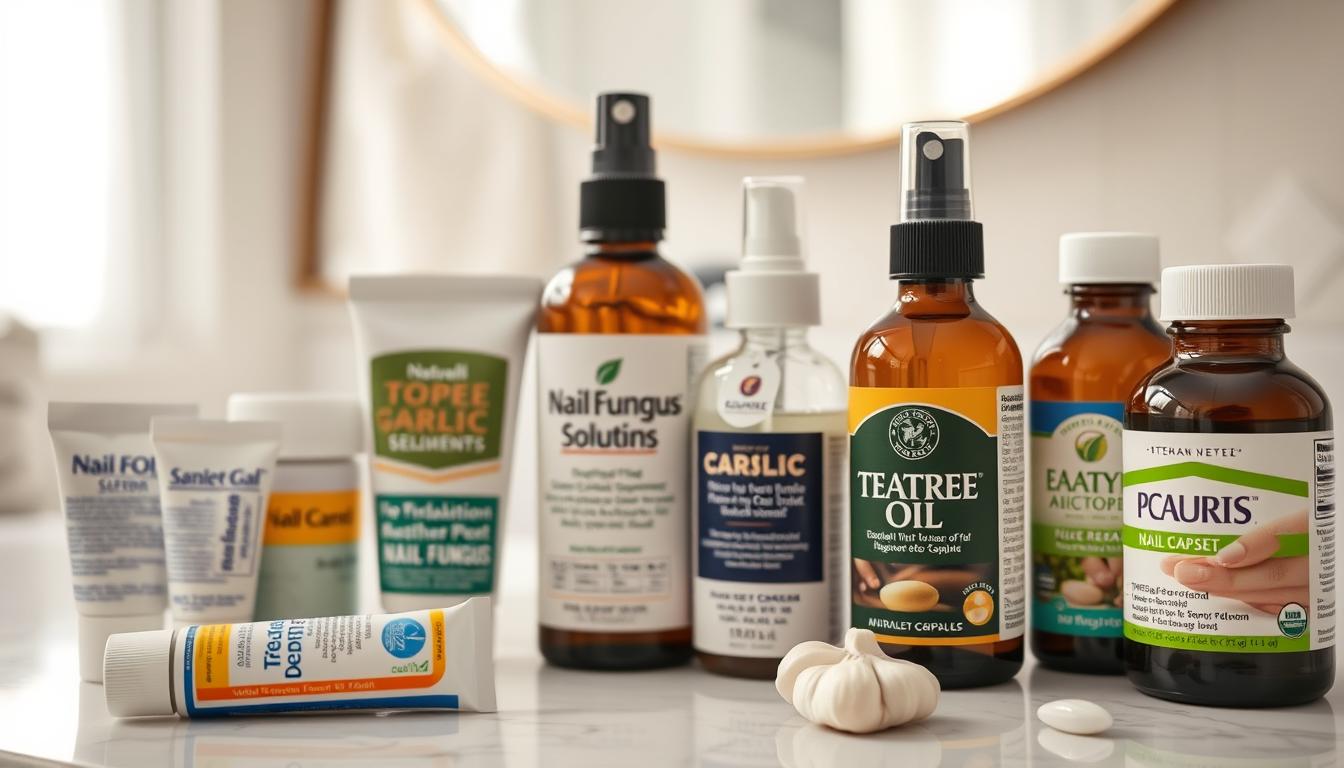
bookmarked!!, I really like your website!
Spot on with this write-up, I actually believe this web site needs a lot more attention. I’ll probably be back again to read through more, thanks for the advice!
I blog often and I genuinely thank you for your information. This article has truly peaked my
interest. I’m going to take a note of your website and keep checking for new details about once per week.
I subscribed to your RSS feed as well.